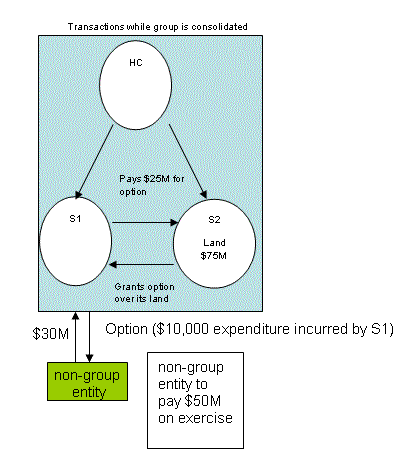Taxation Determination
TD 2004/34
Income tax: consolidation: capital gains: does section 104-10 (CGT event A1) of the Income Tax Assessment Act 1997 apply to the head company of a consolidated group where an option granted within the consolidated group is later transferred to a non-group entity?
-
Please note that the PDF version is the authorised version of this ruling.
FOI status:
may be released| Preamble |
| The number, subject heading, date of effect and paragraphs 1 to paragraphs 5 of this document are a 'public ruling' for the purposes of Part IVAAA of the Taxation Administration Act 1953 and are legally binding on the Commissioner. |
1. Yes. CGT event A1 will happen to the head company where the head company of a consolidated group transfers the option or where the option is transferred by a subsidiary member of that consolidated group.
2. When a member of a consolidated group is granted an option by another group member there are no income tax consequences for the head company because of the single entity rule (SER) in section 701-1 of the Income Tax Assessment Act 1997 (ITAA 1997).
3. However, when the option is transferred from the group to a non-group entity, CGT event A1 happens to the head company because of the change of ownership from the consolidated group to the non-group entity. For instance, where the transfer of the option is by a subsidiary member of the group, the SER takes the transfer to have been by the head company.
4. CGT event A1 happens 'if you dispose of a CGT asset'. In this case 'you' is taken to be the head company and the CGT asset is the option. The head company is recognised as disposing of the option to the non-group entity.
5. The cost base of a CGT asset consists of 5 elements (see subsection 110-25(1) of the ITAA 1997). Those elements are the various amounts of money or property 'you' paid, gave, incurred or are required to pay or give. Again, in this case, 'you' is the head company of the group. As intra-group expenditures and transfers are taken to be the actions of the head company during the period of consolidation and are not recognised for income tax purposes, they cannot be included in an element of the cost base of the option. Only incidental costs incurred by the group to non-group entities relating to the transfer are included in the cost base.
6. Example: HC is the head company of a consolidated group with S1 and S2 being subsidiary members of the consolidated group. While consolidated, S2 grants an option over land it owns to S1 for $25M consideration. S2 does not incur any expenditure in respect of the granting. Subsequently S1 assigns the option to a non-group entity for $30M consideration, incurring $10,000 in legal fees paid to a third party.
7. The diagram below shows the above transactions .

8. In the example there are no income tax consequences from S2 granting an option to S1. The SER, on S1 assigning the option to the third party, has the effect of treating HC as assigning the option to a non-group entity. HC is treated as having received capital proceeds of $30M for the assignment of an option and incurring $10,000 incidental costs forming the second element of cost base of the option. There are no other elements of cost base for the option. HC makes a CGT event A1 capital gain of $29,990,000.
Date of Effect
9. This Determination applies to years commencing both before and after its date of issue. However, it does not apply to taxpayers to the extent that it conflicts with the terms of settlement of a dispute agreed to before the date of the Determination (see paragraphs 21 and 22 of Taxation Ruling TR 92/20).
Commissioner of Taxation
22 September 2004
References
ATO references:
NO 2004/9062
Related Rulings/Determinations:
TR 92/20
TR 2004/11
Subject References:
Consolidation
Legislative References:
TAA 1953 Pt IVAAA
ITAA 1997 104-10
ITAA 1997 110-25(1)
ITAA 1997 701-1
